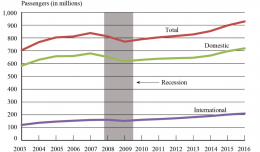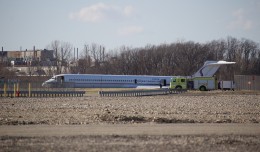Indonesian Low Cost Carrier (LCC) Indonesia AirAsia has confirmed that one of its flights lost contact with air traffic control. Flight 8501, between Juanda International Airport (SUB) in Surabaya, Indonesia and Singapore Changi Airport (SIN) disappeared around 7:24 local time this morning. The flight was operated by an A320, registration PK-AXC. Tracking site FlightRadar24 showed the flight disappearing over the Java Sea, west of Sumatra. Indonesia AirAsia is one of several subsidiaries of Malaysian LCC AirAsia.
Update: 11:40pm EST 12/27 According the Civil Aviation Authority of Singapore (CAAS), flight 8501 was due to arrive in Singapore at 8:30 AM local time. Indonesian authorities have activated search and rescue operations, and Singapore has offered its assistance.
The missing aircraft, PK-AXC, was delivered in September, 2008. It was operated by subsidiary Indonesia AirAsia, which operates a fleet of 30 A320s. Across all of its subsidiaries, AirAsia operates 170 A320s.
Update: 12:25am EST 12/28: Indonesian authorities have released the passenger manifest for Flight 8501. It shows that the flight had 155 passengers onboard, including 1 infant.
Update: 1:20am EST 12/28: Indonesia Air Asia has released more information about those onboard the missing flight. In addition to 155 passengers, there were 2 pilots, 4 flight attendants, and 1 engineer (mechanic) on the flight, for a total of 162 people. Of those, 155 were from Indonesia. The remainder were citizens of South Korea (3), Malaysia (1), Singapore (1), France (1), and United Kingdom (1). Updated 8:40am EST based in new info from the airline
The captain of the flight had a total of 6,100 hours of flight experience, while the first officer had 2,275 hours.
Shortly before contact was lost, Flight 8501 had requested a deviation from its flight path and a higher altitude in order to avoid thunderstorms that were in the area.
Update: 6:00am EST 12/30: On the third day of searching for QZ8501, search and rescue crews believe that they have found the missing Airbus A320. A C-130 performing an aerial search initially discovered debris floating on the water, in an area roughly 10km from the airliner’s last reported position. The debris found includes some that was described as “resembling an aircraft door and an emergency slide.” Further searches have revealed a “shadow” on the seabed that is thought to resemble a major portion of the aircraft. The water in the area where these objects were found is believed to be 80-100 feet deep.
While the Indonesian search and rescue chief had earlier stated that the items found were 95% certain to have come from the missing plane, the nation’s acting director general of civil aviation, Djoko Murjatmodjo, later made a more firm confirmation. “For the time being it can be confirmed that it’s the AirAsia plane.”
Meanwhile, the Indonesian Navy has recovered more than 40 bodies that were found floating in the water near the crash site. The Navy has declared that an around the clock recovery operation is now under way. Additional ships are headed to the area, including at least one from the Singaporean Navy. (Update, 8:50am: there are now conflicting reports saying that as few as three bodies may have been recovered so far)
The president of Indonesia has been given an aerial tour of the wreckage area, and is currently enroute to meet with the families of those on board in Surabaya.
Update: 7:00am EST 12/30: In a statement released by AirAsia a short while ago, the airline announced that The National Search and Rescue Agency Republic of Indonesia (BASARNAS) has confirmed that the debris found earlier did in fact come from Flight 8501. The debris were located in the Karimata Strait, approximately 100 miles southwest of Pangkalan Bun on the island of Borneo.
In the statement, AirAsia Group CEO Tony Fernandes states, ” I am absolutely devastated. This is a very difficult moment for all of us at AirAsia as we await further developments of the search and rescue operations but our first priority now is the wellbeing (sic) of the family members of those onboard QZ8501.
With wreckage found and recovery operations underway, some attention will now turn to the investigation of the cause behind the crash. That investigation will be led by Indonesia’s National Transportation Safety Committee.
Update: 7:40am EST 12/30: In a brief press conference, Indonesian President Joko Widodo expressed his sympathies to the families of those on board. He indicated that the first priority in the recovery operations is to find the remains of all onboard, so that they may be returned to their loved ones. He also expressed his gratitude to the other nations that have been participating in the search operations
Also this morning, airline schedule tracking website AirlineRoute.net has reported that the QZ8501 flight number (as well as the number of the return flight, QZ8502) is being retired effective tomorrow, December 31, 2015. It will be replaced with flight numbers QZ678 and QZ679 for the SUB-SIN and SIN-SUB flights respectively. The flight will continue to operate four times a week on the same schedule.
Update: 5:45pm EST 12/30: Bad weather over the past several days has hampered the search for wreckage and the recovery of victims from Flight 8501. As of earlier today, AirAsia reported that 22 bodies had been recovered. Of those, four had been identified and released to the families.
One of the victims that has been identified is Khairunisa Haidar Fauzi, who was one of the flight attendants onboard Flight 8501. AirAsia Group CEO Tony Fernandes, along with other AirAsia executives, personally accompanied her remains as they were returned to her family. The airline executives also attended her burial.
Late today, an investigative team from France’s Bureau of Enquiry and Analysis for Civil Aviation Safety (BEA) have arrived on scene. The BEA will be a party to the crash investigation, as the investigative agency for the nation where the aircraft was designed and manufactured. The BEA team has brought with them specialized equipment to aid in the search and recovery of the downed jet.
Finally, AirlineRoute.net is reporting that Indonesia AirAsia has suspended their Surabaya to Singapore route. The last flight was flown earlier today.
Developing…








